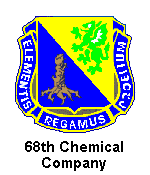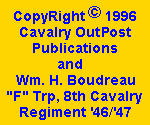
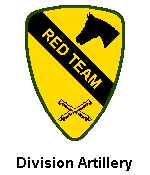
1st Cavalry Division
Artillery Command
Organizational Legacy
"The Red Team"


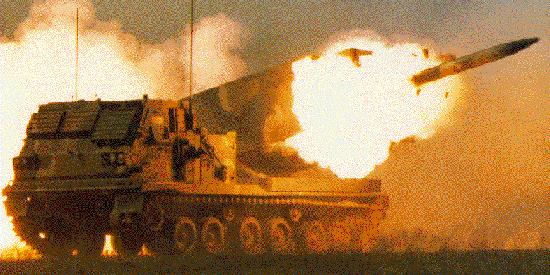 |
|---|
| M-270 Multiple Launch Rocket System (MLRS) |
|---|

Command Distinctive Unit Insignia
 Introduction
Introduction


 The 1st Cavalry Division, a major subordinate command of the US Third Mobile
Armored Corps, is a 19,000 soldier, heavy armored division stationed at Ft.
Hood, TX. As one of the two "on-call" heavy contingency force divisions of the
Army, the First Team has an on-order mission to deploy by sea, air or land to
any part of the world on a short notice. The following narratives, divided in
timeline eras of major operational missions, describes the threat environment,
tactical conditions, evolution of equipment technology and the strategic
methodology employed its manuever command units, the 1st, 2nd, 3rd, 4th and
5th Brigade Combat Team and its Subordinate Units, to contribute to the highly
successful missions enhancement of the warring organization of the 1st Cavalry
Division and the honors they achieved are summarized in the chapters that
follow.
The 1st Cavalry Division, a major subordinate command of the US Third Mobile
Armored Corps, is a 19,000 soldier, heavy armored division stationed at Ft.
Hood, TX. As one of the two "on-call" heavy contingency force divisions of the
Army, the First Team has an on-order mission to deploy by sea, air or land to
any part of the world on a short notice. The following narratives, divided in
timeline eras of major operational missions, describes the threat environment,
tactical conditions, evolution of equipment technology and the strategic
methodology employed its manuever command units, the 1st, 2nd, 3rd, 4th and
5th Brigade Combat Team and its Subordinate Units, to contribute to the highly
successful missions enhancement of the warring organization of the 1st Cavalry
Division and the honors they achieved are summarized in the chapters that
follow.
Mission:
 On Order, the 1st Cavalry Division Artillery has an on-order mission to deploy
by sea, air or land to any part of the world on a short notice in support of
the objectives of the theater Commander. Once engaged with the threat; the
objective is to destroy, neutralize, or suppress the enemy by cannon, rocket,
and missile fires and to integrate all fires into combined arms operations.
On Order, the 1st Cavalry Division Artillery redeploys and prepares for future
operations.
On Order, the 1st Cavalry Division Artillery has an on-order mission to deploy
by sea, air or land to any part of the world on a short notice in support of
the objectives of the theater Commander. Once engaged with the threat; the
objective is to destroy, neutralize, or suppress the enemy by cannon, rocket,
and missile fires and to integrate all fires into combined arms operations.
On Order, the 1st Cavalry Division Artillery redeploys and prepares for future
operations.
Organizational Summary:
 The 1st Cavalry Division Artillery is a subordinate command of the 1st Cavalry
Division, a heavily armored division stationed at Fort Hood, Texas as part of
the US Third Mobile Armored Corps. As an element of the two "on-call" heavy
contingency force divisions of the Army, the Division Artillery, was
previously composed of the 21st Field Artillery, 68th Chemical Company and the
82nd Field Artillery Regiment,
The 1st Cavalry Division Artillery is a subordinate command of the 1st Cavalry
Division, a heavily armored division stationed at Fort Hood, Texas as part of
the US Third Mobile Armored Corps. As an element of the two "on-call" heavy
contingency force divisions of the Army, the Division Artillery, was
previously composed of the 21st Field Artillery, 68th Chemical Company and the
82nd Field Artillery Regiment,
|
|
|---|
| A "Look Back" To "How It Was" |
|---|
 The history of the US Artillery can be traced back to the Military Company of
Massachusetts, which was chartered in 1638, and with other colonial artillery
companies formed what became the Continental Artillery. In April 1775, more
than a century later, the legislature authorized the formation of an artillery
regiment. It would be another century, on 08 January 1869, before MG Philip H.
Sheridan staked out the site that would become Fort Sill, home of the Field
Artillery. Sheridan was leading a campaign into Indian Territory to stop
hostile tribes from raiding border settlements in Texas and Kansas. His
massive winter campaign involved six cavalry regiments, many which later would
be assigned to the 1st Cavalry Division.
The history of the US Artillery can be traced back to the Military Company of
Massachusetts, which was chartered in 1638, and with other colonial artillery
companies formed what became the Continental Artillery. In April 1775, more
than a century later, the legislature authorized the formation of an artillery
regiment. It would be another century, on 08 January 1869, before MG Philip H.
Sheridan staked out the site that would become Fort Sill, home of the Field
Artillery. Sheridan was leading a campaign into Indian Territory to stop
hostile tribes from raiding border settlements in Texas and Kansas. His
massive winter campaign involved six cavalry regiments, many which later would
be assigned to the 1st Cavalry Division.
 On 13 September 1921, when the 1st Cavalry Division organized, the only
assigned artillery organization was composed of the 82nd Field Artillery,
comprised of "A", "B" & "C" Batteries. The tactical significance of the
artillery organizations was recognized on 03 January 1941, with the activation
of the 1st Cavalry Division Artillery and the Headquarters and Headquarters
Battery at Fort Bliss, Texas. Throughout 1942, the 1st Cavalry Division
Artillery underwent intensive training by honing its readiness to a fine
edge.
On 13 September 1921, when the 1st Cavalry Division organized, the only
assigned artillery organization was composed of the 82nd Field Artillery,
comprised of "A", "B" & "C" Batteries. The tactical significance of the
artillery organizations was recognized on 03 January 1941, with the activation
of the 1st Cavalry Division Artillery and the Headquarters and Headquarters
Battery at Fort Bliss, Texas. Throughout 1942, the 1st Cavalry Division
Artillery underwent intensive training by honing its readiness to a fine
edge.
 Next, the 1st Cavalry Division Artillery wrote the first chapter of its
history - The Admiralty Islands Campaign. This was followed by participation
in the Leyte and Luzon Campaigns from 06 September 1945 to 1950. The Division
Artillery performer occupation duty in Japan and girded itself for its next
call to combat.
Next, the 1st Cavalry Division Artillery wrote the first chapter of its
history - The Admiralty Islands Campaign. This was followed by participation
in the Leyte and Luzon Campaigns from 06 September 1945 to 1950. The Division
Artillery performer occupation duty in Japan and girded itself for its next
call to combat.
 It weas not long before the DIVArty became involved in Korea. During the first
few weeks, the artillerymen of the Division found themselves fighting with
small arms alongside their artillery pieces. The cannoneers of the 1st Cavalry
Division Artillery continued to do their share in the fighting in Korea during
1950 - 1951.
It weas not long before the DIVArty became involved in Korea. During the first
few weeks, the artillerymen of the Division found themselves fighting with
small arms alongside their artillery pieces. The cannoneers of the 1st Cavalry
Division Artillery continued to do their share in the fighting in Korea during
1950 - 1951.
 In July 1965, the 1st Cavalry Division Artillery's colors were transferred to
Fort Benning, GA, where it became transformed as part of the 1st Cavalry
Dvision (Airmobile). The 1st Cavalry Division Artillery deployed to Vietnam in
September 1965. Across all four Corps areas, as well as the incursion into
Cambodia, the airmobile "Redlegs" checkmated the enemy at every turn. In May
1971, the colors of the 1st Cavalry Division Artillery arrived at Fort Hood,
TX.
In July 1965, the 1st Cavalry Division Artillery's colors were transferred to
Fort Benning, GA, where it became transformed as part of the 1st Cavalry
Dvision (Airmobile). The 1st Cavalry Division Artillery deployed to Vietnam in
September 1965. Across all four Corps areas, as well as the incursion into
Cambodia, the airmobile "Redlegs" checkmated the enemy at every turn. In May
1971, the colors of the 1st Cavalry Division Artillery arrived at Fort Hood,
TX.
 In 1991, the Red Team helped pave the way for the1st Cavalry Division's charge
into Iraq, while showering the enemy with over 9,000 cannon round and MLRS
rockets. The artillery's lethal effects directly contributed to the success of
the theater's deception plan. DIVARTY units were the first United States Army
artillery units to fire cannon and copperhead rounds as well as MLRS rockets
in combat during Desert Storm.
In 1991, the Red Team helped pave the way for the1st Cavalry Division's charge
into Iraq, while showering the enemy with over 9,000 cannon round and MLRS
rockets. The artillery's lethal effects directly contributed to the success of
the theater's deception plan. DIVARTY units were the first United States Army
artillery units to fire cannon and copperhead rounds as well as MLRS rockets
in combat during Desert Storm.
 Following the major waring encounters of the Gulf War, the 1st Cavalry
Division Artillery deployed in support of the peacekeeping mission in
Bosnia-Herzegovina in support of Operation Joint Forge.
Following the major waring encounters of the Gulf War, the 1st Cavalry
Division Artillery deployed in support of the peacekeeping mission in
Bosnia-Herzegovina in support of Operation Joint Forge.
 The Division returned from Operation Iraqi Freedom II, serving as Task Force
Baghdad. While in Iraq, the Div Arty Headquarters served as the 5th Brigade
Combat Team (BCT) of the Division and several FA battalions served as
motorized task forces.
The Division returned from Operation Iraqi Freedom II, serving as Task Force
Baghdad. While in Iraq, the Div Arty Headquarters served as the 5th Brigade
Combat Team (BCT) of the Division and several FA battalions served as
motorized task forces.
 On 26 May 2005, following the return from its Operation Iraqi Freedom II
deployment, the 5th Brigade (Provisional), formally the Division Artillery,
1st Cavalry Division was inactivated at Fort Hood, Texas. Subsequently, on 30
May 2005, the DIVARTY, 1st Cavalry Division, which had returned to its
traditional role, was inactivated as part of the US Army's transformation
towards a modular force.
On 26 May 2005, following the return from its Operation Iraqi Freedom II
deployment, the 5th Brigade (Provisional), formally the Division Artillery,
1st Cavalry Division was inactivated at Fort Hood, Texas. Subsequently, on 30
May 2005, the DIVARTY, 1st Cavalry Division, which had returned to its
traditional role, was inactivated as part of the US Army's transformation
towards a modular force.
 Since its organization, 25 artillery units have been assigned to the Division
Artillery. Of the currently assigned units, the 21st Field Artillery became a
member of the "Red Team" in July 1960 when the 1st Cavalry Division was
stationed in Korea. The last member of the Division Artillery, the 68th
Chemical Company, joined the 1st Cavalry Division in March 1963 as part of the
Reorganizational Objective Army Division (ROAD) which included divisional
level integration of what had been support functions, into the Line
Organization.
Since its organization, 25 artillery units have been assigned to the Division
Artillery. Of the currently assigned units, the 21st Field Artillery became a
member of the "Red Team" in July 1960 when the 1st Cavalry Division was
stationed in Korea. The last member of the Division Artillery, the 68th
Chemical Company, joined the 1st Cavalry Division in March 1963 as part of the
Reorganizational Objective Army Division (ROAD) which included divisional
level integration of what had been support functions, into the Line
Organization.
 The capability of the Division Artillery had been developed in conjunction
with the long history and needs of the 1st Cavalry Division. It becamne the
combination of the experienced training received by each dedicated member of
the Team and adherenced the performance level and traditions of the past.
Highlights of the many subsequent historical critical missions performed by
members of the Divisional Artillery and the honors they achieved are
summarized in the chapters that follow:
The capability of the Division Artillery had been developed in conjunction
with the long history and needs of the 1st Cavalry Division. It becamne the
combination of the experienced training received by each dedicated member of
the Team and adherenced the performance level and traditions of the past.
Highlights of the many subsequent historical critical missions performed by
members of the Divisional Artillery and the honors they achieved are
summarized in the chapters that follow:
Legacy Command Unit
1st Cavalry Division Artillery Command |
|---|
|
|---|
| Date Of Issue - 14 February, 2012 |
|---|

 This folio of material highlights of the many subsequent historical critical
missions performed by members of the 1st Cavalry Division Artillery, whose
actions, operations and the many critical issues resolved over its 72+ years
history to meet the changing threat and the honors they achieved are
summarized in the following sections:
This folio of material highlights of the many subsequent historical critical
missions performed by members of the 1st Cavalry Division Artillery, whose
actions, operations and the many critical issues resolved over its 72+ years
history to meet the changing threat and the honors they achieved are
summarized in the following sections:
 Table of Contents
Table of Contents
















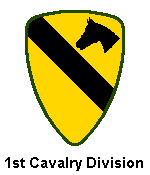



 If none of the data that you have found by surfing the reference unit chapter
titles and indexes measures up to your interests, you may want to deploy the
R&S (Reconnaissance and Surveillance) Scouts to search and identify keywords
or subjects within individual unit pages. Enter the descriptive keyword or
search terms(s) in the input field and "Click" on the Search button to screen the multiple DataBases of
the Cavalry OutPost and the garrisoned occupants - "The 1st Cavalry Division
and its Subordinate Units".
If none of the data that you have found by surfing the reference unit chapter
titles and indexes measures up to your interests, you may want to deploy the
R&S (Reconnaissance and Surveillance) Scouts to search and identify keywords
or subjects within individual unit pages. Enter the descriptive keyword or
search terms(s) in the input field and "Click" on the Search button to screen the multiple DataBases of
the Cavalry OutPost and the garrisoned occupants - "The 1st Cavalry Division
and its Subordinate Units".
 The search action will open the "first-team.us WebSite - R&S Scout Report",
which displays a listing of WebSite Titles and HTML Summaries that contain the
specific search term(s) of interest. To review any that best depicts a match
of your search term(s), "Click" on the WebSite Title to open a New Window.
After the WebSite is fully loaded, use the browser [EDIT/Find] Tool Button to
locate the search term within the page. After reviewing, close the New Window
to return to the listing of WebSites.
The search action will open the "first-team.us WebSite - R&S Scout Report",
which displays a listing of WebSite Titles and HTML Summaries that contain the
specific search term(s) of interest. To review any that best depicts a match
of your search term(s), "Click" on the WebSite Title to open a New Window.
After the WebSite is fully loaded, use the browser [EDIT/Find] Tool Button to
locate the search term within the page. After reviewing, close the New Window
to return to the listing of WebSites.
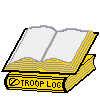



 If this is your first review of the Outpost of the 1st Cavalry Division and
its Subordinate Units, you may want to record your own report on your findings
during your visit, or perhaps you may want to review the log entries of other
visitors.
If this is your first review of the Outpost of the 1st Cavalry Division and
its Subordinate Units, you may want to record your own report on your findings
during your visit, or perhaps you may want to review the log entries of other
visitors.

To report on your findings,
"click" on the "Report-In"
Index Tab of the Troop Log. |
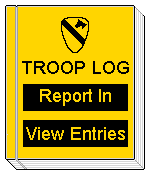
|

To review entries of others,
"Click"on the "View Entries"
Index Tab of the Troop Log. |
|---|

 As you journey through the history of the 1st Cavalry Division and its
assigned elements, you may find it interesting enough to send a message to
your friends and extend them an invitation for the opportunity to review the
rich history of the Division. We have made it easy for you to do. All that is
required is for you to click on the Push Button below, fill in their eMail
addresses and send.
As you journey through the history of the 1st Cavalry Division and its
assigned elements, you may find it interesting enough to send a message to
your friends and extend them an invitation for the opportunity to review the
rich history of the Division. We have made it easy for you to do. All that is
required is for you to click on the Push Button below, fill in their eMail
addresses and send.


|
The TITLE and URL of this WebSite are automatically read, formatted
and entered into your standard eMail form. |
|
|
Note - The eMail Message is processed and transmitted On-Line to the
addressee(s) via your Internet Provider.
Copyright © 2002, Cavalry Outpost Publications ® |




 eMail Your WebSite Comments.
eMail Your WebSite Comments.


 Return to "MyOwnPages"©.
Return to "MyOwnPages"©.

 Copyright © 1996, Cavalry Outpost Publications ® and
Trooper Wm. H. Boudreau, "F" Troop, 8th Cavalry Regiment (1946 - 1947). All
rights to this body of work are reserved and are not in the public domain, or
as noted in the bibliography. Reproduction, or transfer by electronic means,
of the History of the 1st Cavalry Division, the subordinate units or any
internal element, is not permitted without prior authorization. Readers are
encouraged to link to any of the pages of this Web site, provided that proper
acknowledgment attributing to the source of the data is made. The information
or content of the material contained herein is subject to change without
notice.
Copyright © 1996, Cavalry Outpost Publications ® and
Trooper Wm. H. Boudreau, "F" Troop, 8th Cavalry Regiment (1946 - 1947). All
rights to this body of work are reserved and are not in the public domain, or
as noted in the bibliography. Reproduction, or transfer by electronic means,
of the History of the 1st Cavalry Division, the subordinate units or any
internal element, is not permitted without prior authorization. Readers are
encouraged to link to any of the pages of this Web site, provided that proper
acknowledgment attributing to the source of the data is made. The information
or content of the material contained herein is subject to change without
notice.
Revised 17 Novt '12 SpellChecked






 Introduction
Introduction

